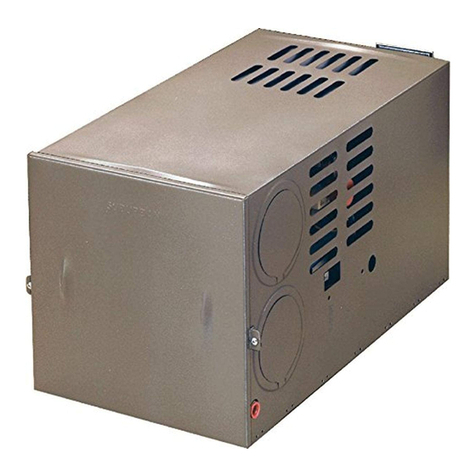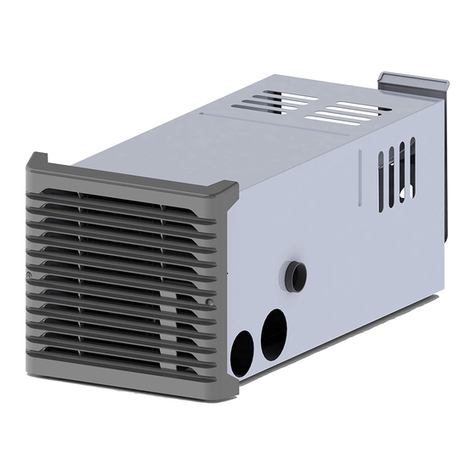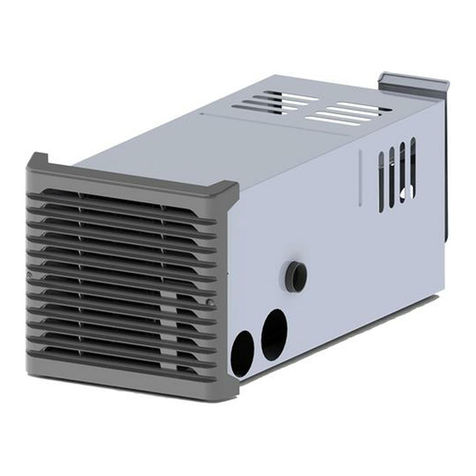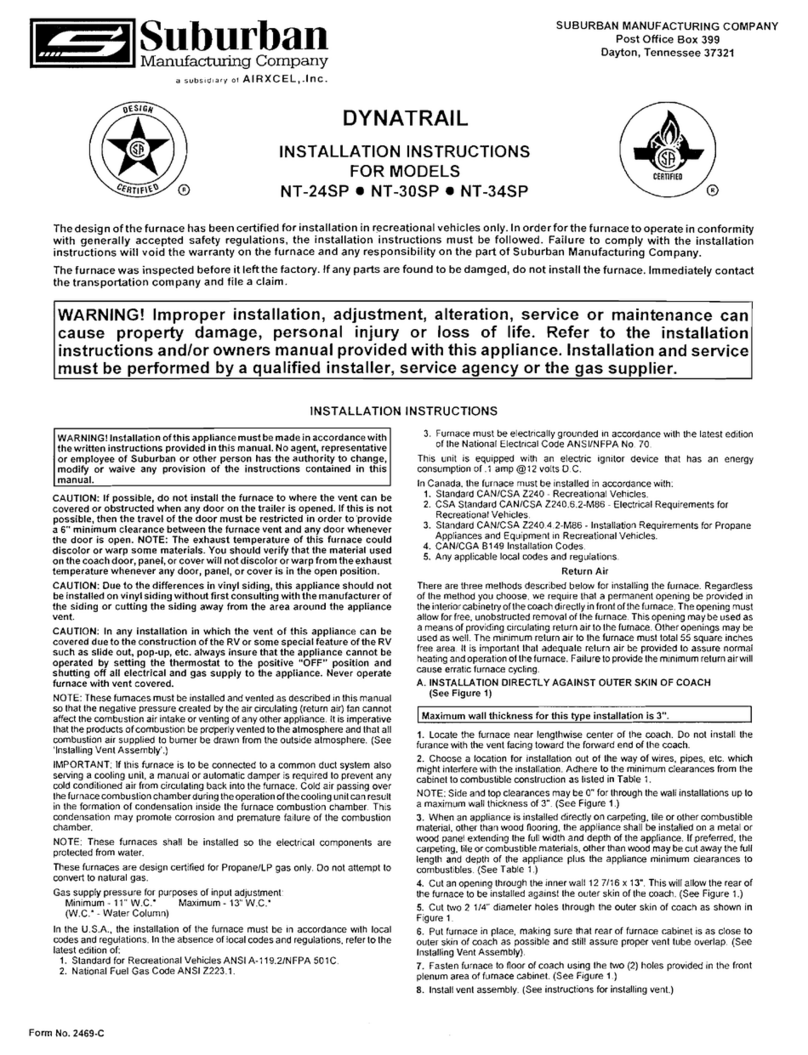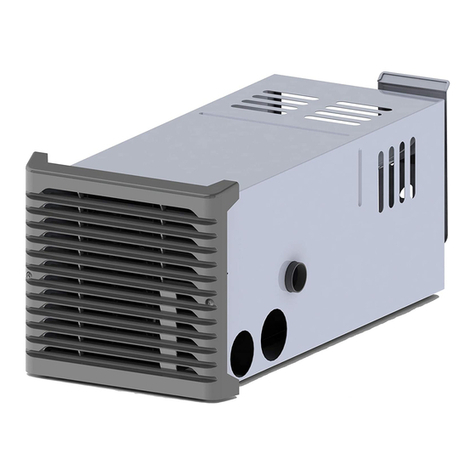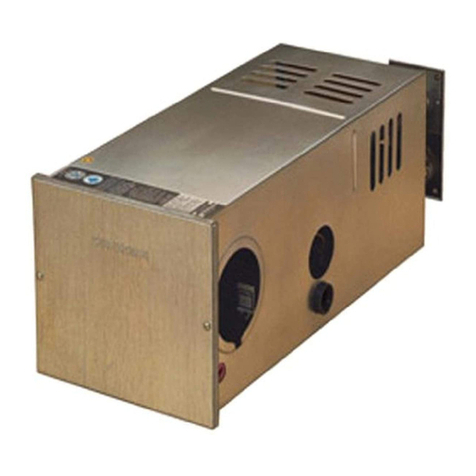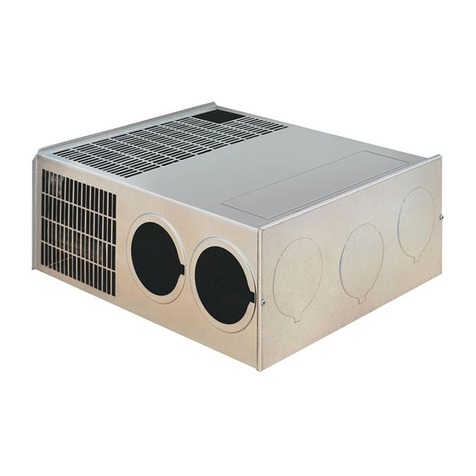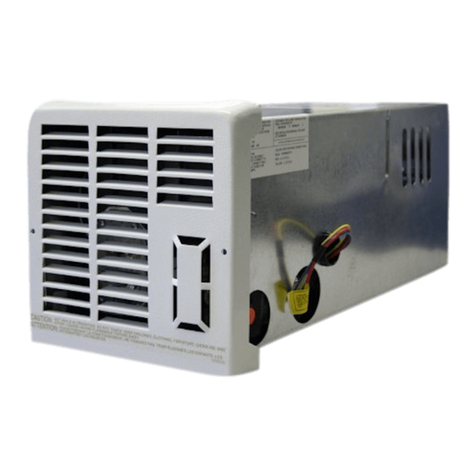CAUTION! Combustion airmustnotbedrawnfrom the living area. Allair for
combustion mustbedrawn from theoutsideatmosphere. Allexhaustgases
mustbe vented tothe outsideatmosphere
-
never insidetheRV. Therefore,
itis essential to insure that the vent cap and tube assemblies are properly
installed.
1.
Apply caulking to RV skin behind vent capasshown in ~ig'ure1 Apply caulking
generously around perimeter of vent cap and across center as shown
2.
Insert Intake tube through RV ski11and slide it onto the furnace intake (See
Figure 2
)
Minimum tube overlap of 112" is requlred
3.
Insert vent cap exhaust tube through RV skin and slide it onto the furnace
exhaust (See Figure 2
)
Minimumtube overlap of 1 114" is required
4.
Attach vent cap assembly to outer sldn of RV wilh the six
(6)
screws provided
Do not install vent assembly upside down The words "Suburban" and "Dayton.
Tenn." must be right side up.
CONNECTING GAS SUPPLY
Connectthe gas supply to the furnace at the manifold,following the suggestions
outlined below. It will be necessary10 hold the flare fitting on the furnace manifold
when connecting or loosening gas line
NOTE The compound used on threaded joints must be resistant to liquefied
petroleum (LP) gas.
NOTE.The appliance must be disconnected from the gas supply piping system
during any pressure testing of that system at test pressure in excess of 112 PSIG.
The appliance must be isolated from the gas supply piping during any pressure
testing of the gas supply piping system at test pressure equal to or less than 112
PSIG.
1.
A 318" male flare connection is provided for gas line hookup.Some standards
may require the use of a manual shut off valve in the gas line external to the
furnace cabinet.
2.
Inorder to maintain acheck ofgas supplied pressure to the furnace, Suburban
advises the installer to provide the 118 NPT plug tap for test gauge connection
immediately upstream of the gas supply connection to the furnace and that it be
readily accessible.
3.
After the furnace has been connected to the gas supply, all jo~ntsmust be
checked for leaks.
WARNING! Nevercheckfor leakswithanopen flame. Turn onthe gasand
apply soapy water to alljoints to see if bubbles are formed.
CONNECTING ELECTRICAL SUPPLY
CAUTION: This furnaceisdesigned for negativeground
12
volt D.C. system
,
only. Do not attempt to alter the furnace for a positive ground system or
connectthefurnace directly to
115
voltsA.C. Damageto furnace component
parts will occur.
Be sure all wiring to the furnace is of heavy enough gauge to keep the voltage
drop through it to a minimum andto provideenough powerfor start-upsurge. No
1'2gaugewire is recommended.Ifany ofthe original wire that is suppliedwiththe
appliance must be replaced,itmust be replacedwithtype 105"
C
or itsequivalent.
Powersupplyconnections areto beonthe right side of the furnace. The wires are
color coded, red for positive
(+)
and yellow for negative
(-).
This polarity must be
observed so the furnace motor will run the proper direction of rotationto insure
correct air delivery. (See wiring diagram.)
If the furnace power supply is to be from a converter, we recommend that the
converter system used to power the furnace be wired in parallelwith the battery.
This will serve two purposes:
1.
Provide a constant voltage supply to the furnace.
2.
Filter anyA.C. spikes or volt surges.
CONNECTING DUCTS TO FURNACE
The following duct requirements must be followed in order to assure proper
operation of the furnace:
A.
The minimum open duct areas listed below must be maintained throughout
entire duct system including through register:
NOTE: Ducts terminating in a dead air space (like holding tank
compartments) with no means for return air recirculation should not be
counted in the required duct area. Also ducts
2"
in diameter or smaller
should not be counted inthe required duct area.
.
6.
Maketheduct connections at the furnacecabinet tight. Looseconnect~onswill
result inoverheating of the component parts on the furnace and a reduction of the
heated air flow through the duct system.
C. Avoid makingany sharpturns inthe duct system Sharp turns will increase the
static pressure in the plenum area and could cause the furnace to cycle.
D. Avoid making a lot of turns in the duct system. The straighter the duct system,
the better the performanceof the furnace.
E.
Maintain a minimum of 114" clearance where ducts pass through any
combustible construction, such as coach cabinetry. (See Figure 3
)
NOTE: UL
llsted duct materials can be
0
clearance.
F. Do not install air boosters in the duct system Such devices wlll cause the
furnace lo cycle on limit and to have erratic sail switch operation
NOTE After installation of thefurnace and duct system iscompleted, adjustments
must be made to obtain a temperature rise within the range
specified
on the
Rating Plate INSTALLING THERMOSTAT
Locate the room thermostat approximately 4-112 feet above the floor on an inside
bulkhead where it is not affected by heat from any source except room air.
Connect thermostat wiring to the bluewires on right s~deof furnace. (Seewiring
diagram
)
PREVENTIVE MAINTENANCE
WARNING! Ifthe user ofthis appliance fails tomaintain itinthe condition
inwhich it was shipped from the factory or if the appliance is not used
solely for its intended purpose or if appliance is not maintained in
accordance with the instructions in this manual, then the risk of a fire
andlor the production of carbon monoxide exists which can cause
CAUTION: Labelallwires beforedisconnecting forservicing. Properpolarity
must be observed sothe furnace motorwillrunwith theproper directionof
rotation to insure correct air delivery. (See wiring diagram).
CAUTION: Label all wires prior to disconnection when servicing controls.
Wiring error cancause improper and dangerous furnace operation.
Always verify proper operation of furnace after servicing.
Your furnace should be inspected by a qualified service agency yearly before
turning the furnace on. Particular attention should be given to the following Items.
1.
lnspect furnace installation and vent termination to be sure furnace is properly
secured in place (see Installation Instructions), that vent terminates to the
atmosphere, andthat vent tubes overlap properly (see InstallingVent Assembly.)
2.
lnspect chamber and venting to assure that these components are physically
sound wlthout holes or excessive corrosion and that the installation and/or re-
installation is Inaccordance with Suburban's installation instructions. (Reference
installation manualsuppliedwith furnace.)
WARNING! It is imperative that the products of combustion be properly
vented to atmosphere and that all combustion air supplied to burner be
drawn from outside atmosphere.
3.
Check the base on which furnace is mounted. Besure it is physically sound.
void of any sagging, deterioration, etc.
4.
lnspect furnace, the venting, ducting and gas piping lo furnace for obvious
slgns of deterioration. Correct any defects at once.
5.
lnspect combustion chamber for restrictions in exhaust or intake. It is
imperal~vethat the flow of intake combustion air and the flow of exhaust gases
being expelled to the outside atmosphere not be obstructed. Any soot or loose
debr~sshould be blown out using compressed air. (See Figure
7.)
6.
lnspect all gaskets. If any gaskets show signs of leakage or deterioration.
replace them. Safe operation of Ihe furnace depends on all gaskets being tight.
7.
lnspect return air inlet openings to the furnace. Remove any restrictions to
assure adequate air flow.
You, as the ownerluser, should inspect the furnace monthly during the
heating season for presence of soot on vent. Operating the furnace under this
condition could lead to serious property damage, personal injury or loss of life. If
soot is observed on the vent, immediately shut the furnace down and contact a
qualified
service agency.
Listed below are several safety related items that you should follow during the
heating season to assure continued safe operation of the furnace.
1.
lnspect furnace venting. Venting mustbefree ofobstructions, void of soot,and
properly terminated to the atmosphere. (See Installing Vent Assembly.)
WARNING! Do not installscreens over the vent for any reason. Screens
will become restrictedand cause unsafefurnace operation. Accessories
are being marketed for RV products which we do not recommend. For
your safety, only factory authorized parts aretobe usedonyour furnace.
2.
Periodically inspect the vent for obstructions or presence of soot. Soot is
formed whenever combustion is incomplete.This is your visual warning that the
furnace is operating in an unsafe manner. If soot is present, immediately shut
furnace down and contact your dealer or a qualified service person.
3.
Keep furnace clean. Morefrequent cleaning maybe required due to excessive
lint from carpeting, bedding material, etc. It is imperative that control
compartments, burners and circulating air passageways of the appliance be kept
clean.
4.
The motor is permanently lubricated and requires no oiling





